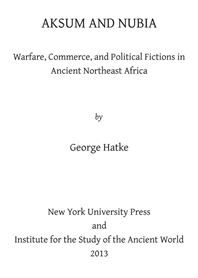
The Ethiopian kingdom of Aksum and the Nubian kingdom of Kush were two of the great African civilizations of antiquity. Both were expansionist polities linked to the outside world through long-distance trade and have left rich records of their respective histories in the form of monuments and inscriptions. Aksum dominated the northern highlands of Ethiopia from at least the turn of the Common Era down to the seventh century, Kush the middle Nile Valley as far south as the lower Blue Nile from the early ninth century BCE to the mid-fourth century CE. Thanks to these inscriptions, as well as to references in Graeco-Roman literature and foreign imports that have survived in the archaeological record, it is possible to reconstruct a fairly detailed history of how Aksum and Kush interacted with the outside world.
To the extent that conflict between the two kingdoms occurred, there seems to have been an imbalance of military power, for while what textual evidence does survive from the reigns of Ousanas and ‘Ēzānā records that the Aksumites invaded Nubia on two occasions, there is little evidence of Kushite military activities to the east of the Nile Valley. A far greater threat to Aksum than Kush was the Noba, a Nubian-speaking group already ensconced in Kush, who attacked Aksum’s western frontier in the fourth century CE. Overall, however, Nubia was never as important to Aksum geopolitically as Arabia. Despite the evidence of Aksumite military activities in Nubia, Aksum was always more interested in its Arabian neighbors across the Red Sea, and is known to have occupied much of present-day Yemen in the third century and again in the sixth under the leadership of the great warrior-king Kālēb (c. 510-540 CE). By contrast, no full-scale occupation of Nubia was ever attempted by the Aksumites. Nevertheless, the fact that Aksum was victorious in its confrontations with Nubia in the fourth century provided fertile grounds for developing the political fiction of rule over Nubia, a political fiction maintained by later Aksumite kings. It is no surprise, then, to find Kālēb and his son and successor Wa‘zeb (c. 540-560 CE) laying claim to Kush and the Noba in their royal titles, side by side with their parallel claims to vast tracts of territory in South Arabia.
The present study contends that the reasons for the seemingly weak ties between Aksum and Nubia can be explained by the geographical orientation of the Ethiopian Highlands and the middle Nile Valley. This is hardly reason to assume rigid geographical determinism, however, since Aksumite records of war with Nubia indicate quite clearly that the middle Nile Valley, though not as important to Aksum either politically or economically as South Arabia, was still by no means insignificant strategically to the Ethiopian kingdom. It will be argued that the main cause for conflict between Kush and Aksum in the fourth century had less to do with political or economic rivalry at the highest level, than with the security of the frontier region that separated them. Documentation for this conflict is provided by a series of Aksumite inscriptions in Greek and Ge‘ez from the reigns of Ousanas and ‘Ēzānā. Following the fourth century we no longer have the benefit of such documentation of Aksumite-Nubian relations. Indeed there is no evidence at all for Aksumite relations with Nubia in the fifth century, after the fall of Kush. In the sixth century it becomes possible to pick up the trail once more, since it is at that time that we find archaeological and literary evidence of contact between Aksum and the Nubian kingdom of Alodia. While this study makes no attempt to substantially rewrite the history of Aksumite-Nubian contact, it is hoped that it can at least clarify what we can and cannot say about relations between the two regions, as well as draw attention to the need for further archaeological research in the still understudied area between the Nile Valley and the Ethiopian Highlands.

